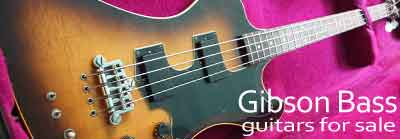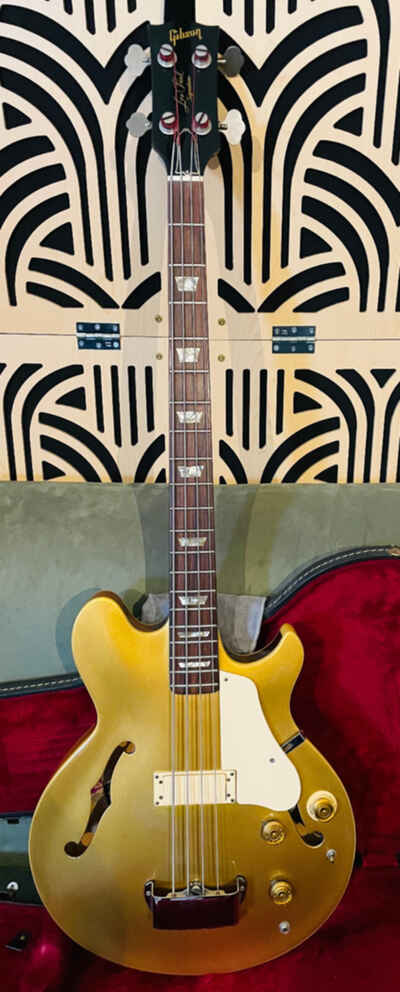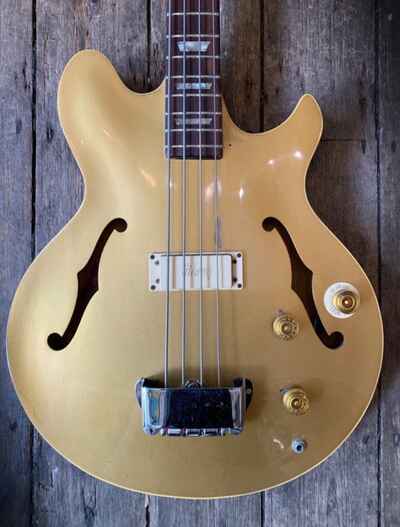Gibson Les Paul Signature Bass specifications
The Les Paul Signature Bass was Gibson's first long scale electric acoustic bass, blending the tradition of the hollow body EB2, and the gold-topped Les Paul guitar, with the advanced low impedance electronics of the Les Paul Triumph bass.
Les Paul had been developing guitars, and guitar electronics for a very long time by the mid 1970s. The guitar bearing his name was, electronically speaking, fairly simple, but by the late 1960s he had designed a number of guitars and companion basses using the latest low impedance circuitry. The 1969 Les Paul bass and 1971 Les Paul Triumph were both great sounding instruments, offering very wide tonal palettes... but, Paul wasn't completely happy: firstly he regarded theses basses as too heavy. Secondly he preferred a longer scale "I tried to talk them out of staying with the short scale, but they didn't want to change". Finally he thought the controls too complicated "The Triumph sounded so good it was scary; it was the finest bass I knew how to come up with, but the kids of that time were not ready for so many options. If I could have done something different, I would have made a bass with one great sound. Simpler is better - like a water faucet".
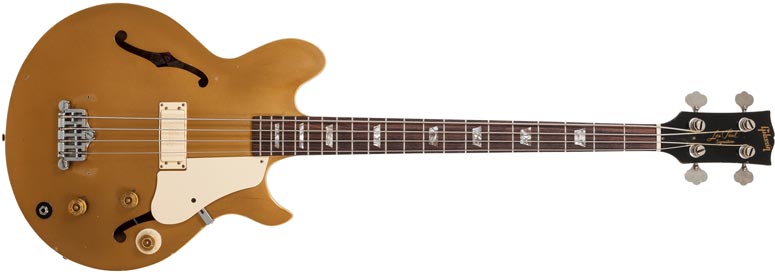
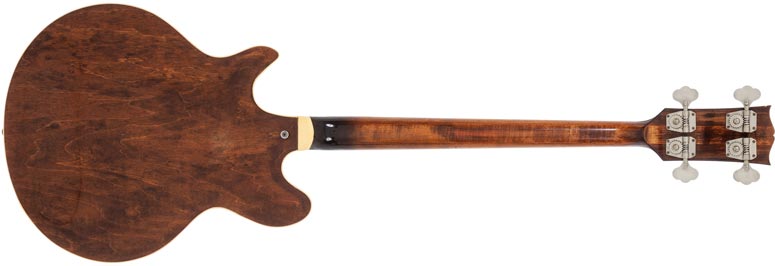
Above: 1974 Gibson Les Paul Signature bass. image: Heritage Auctions
So two years after the launch of the Triumph, the Les Paul Signature bass appeared, addressing all of the perceived failings. Paul had spent some time designing this bass. When Julien's auctions sold off Paul's huge guitar collection in 2012, several heavily customised 1968 EB2 basses came to light, each with one (sometimes two) low impedance pickups in different positions with different circuitry. These experimental basses laid the groundwork for the new model, specifically in terms of circuitry. The Les Paul Signature bass was semi-hollow, with just one pickup, but unlike the EB2, with a long (34") scale length. It had a body shape somewhere quite like an EB2 (top cutaway) but with a Les Paul-style lower cutaway for better fretboard access. But unlike the (largely inaccessible) two-octave Triumph and Les Paul bass necks, the Signature only had 20 frets. It did have a maple centre block to reduce feedback, though one that did not actually touch the instrument's top; giving a good balance between hollow and semi-hollow construction, and keeping the weight down somewhat. It had two output jacks (high and low impedance), a volume and tone control, and a 'level' switch. Simple. Ultimately, Paul's analysis with the 'problems' of the Triumph proved incorrect, as the Triumph outsold the Signature in every year the two were available. See the Les Paul Signature bass shipping data.
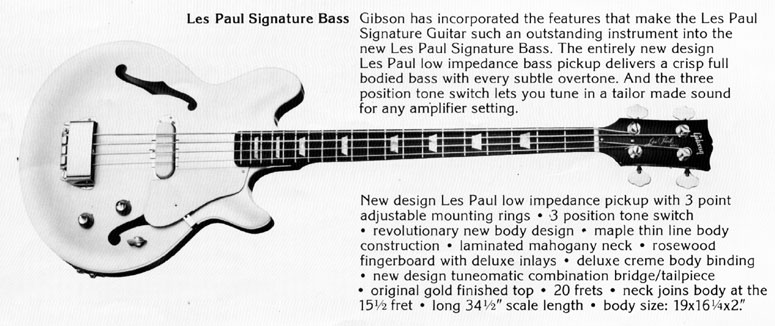
above - 1973 Les Paul Signature Bass - taken from the 'Look ahead to Gibson' brochure of that year. This early example has several 'prototype' features. Notice the chicken head switch, curved pickups with chrome surrounds, and that both output jacks are on the edge of the body. These pickups are the same style as on other Les Paul low impedance basses, the Les Paul Bass and Triumph. Also the specifications describe a different body size and thickness compared to those described in the 1975 catalogue below (19" x 16 1/4" x 2" vs 18 1/4" x 16" wide x 1 5/8")
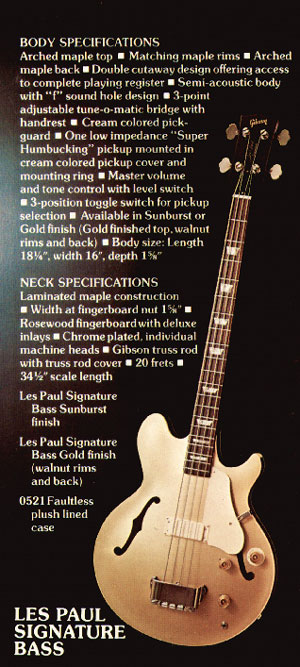
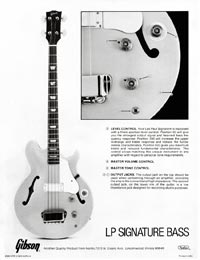
The level control was designed to match the bass tone with different amplifiers: the three settings were 50 (strongest signal, heaviest bass), 200 (increases upper midrange and treble frequencies, reducing fundamental) and 500 (maximum treble and reduced fundamental characteristics). See the description of controls.
The first examples were produced in 1973, and shipped until at least 1979, though more than three quarters (428 out of 627 total) left the Kalamazoo plant (where all were built) in 1974.
The price of this bass rose from its launch; $525 to $629 in January 1975. Sales dropped to 1/15th of the levels of 1974. To combat this the price, was slashed to $499 in the November of that year; lower than the launch price. This was unheard of - the first time a Gibson bass had been offered at a price lower than its original price. But the mid-seventies were an exceptional time for US guitar makers. It was to no avail; sales never picked up, and the price stayed at $499 until its last price-list appearance in 1977.
left The Les Paul Signature was included in the 1975 Gibson Bass catalog. This represents the production model, with a rectangular pickup with plastic surround, and one output jack on the front of the body, and one on the side.
The Les Paul Signature bass was revived and updated in the 1990s, when Jack Casady suggested Gibson reissue the model with some modifications. Like Les Paul before him, Jack Casady had some experience designing guitar electronics. Read about how he teamed up with Epiphone engineers to create the Jack Casady Signature bass, based on the Les Paul Signature bass in his interview with FlyGuitars here - Jack Casady interview.
Gibson Les Paul Signature bass for sale
1974 Gibson LES PAUL SIGNATURE BASS
Milford, Delaware, 199**, UNITED STATES OF AMERICA
$6900
1974 GIBSON LES PAUL SIGNATURE BASS - GOLD & FLIGHT CASE
London, SW6***, UNITED KINGDOM
£5250
1974 GIBSON LES PAUL SIGNATURE BASS - GOLD
Here is rare Gibson Les Paul Signature Bass in good original condition. Arched Maple top, Walnut back and sides. Single ?Super Humbucking?? pick up, semi hollow with a 34 inch scale length, 20 fret, maple centre block, a master volume and tone and a rotating three setting level switch. Laminated Mah gany neck and a Three point Tunomatic bridge. Two outputs, one high and one... more

